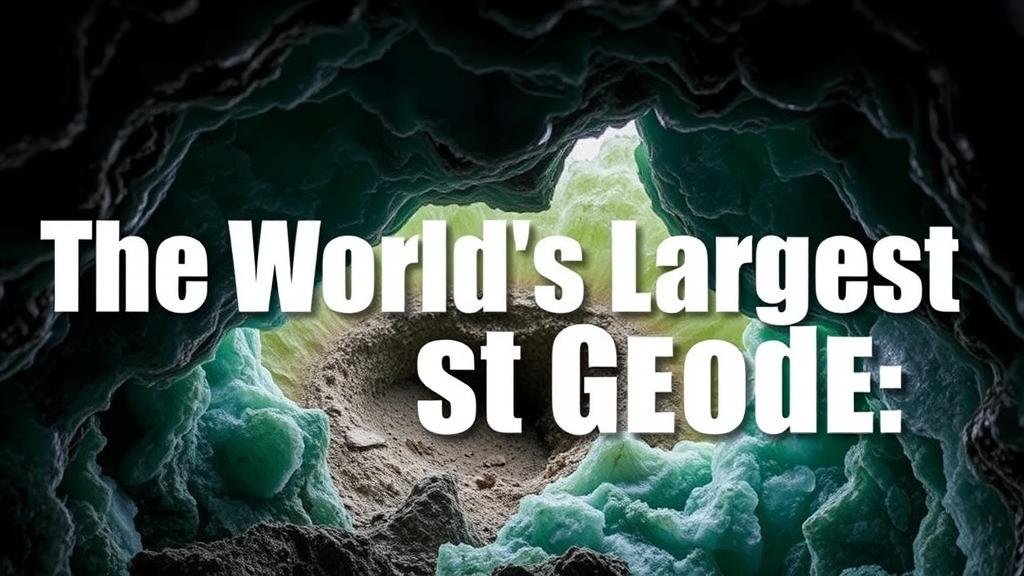The World’s Largest Geodes: Cracking Open Nature’s Underground Treasures
The World’s Largest Geodes: Cracking Open Nature’s Underground Treasures for Rockhounds and Mineral Collectors
Geodes, often described as natures hidden treasures, are hollow rock formations filled with mineral crystals. These geological wonders form over millions of years through volcanic activity, sedimentary processes, and mineral deposition. For rockhounds and mineral collectors, the allure of geodes lies not only in their stunning beauty but also in the thrill of seeking out these natural masterpieces.
Understanding Geodes: Formation and Composition
Geodes typically originate from gas bubbles in volcanic rock or limestone. As mineral-rich water seeps through the rock, it deposits layers of minerals, gradually filling the cavity. Key minerals found in geodes include quartz, agate, calcite, and amethyst. The color and type of the crystals depend on the minerals present during the formation process.
The average size of geodes varies widely, from less than an inch to several feet across. But, the largest geode ever discovered can be found in the Cave of the Crystals in Chihuahua, Mexico. This stunning formation measures about 36 feet long and contains selenite crystals that can reach lengths of over 12 feet.
Notable Examples of Large Geodes
While the Cave of the Crystals is a spectacle in its own right, several other notable geodes also capture the attention of collectors:
- Keokuk Geode: Located in Keokuk, Iowa, this geode is known for its beautiful quartz and calcite formations. The largest found weighed over 80 pounds.
- Sweetwater Geode: Found in Sweetwater, Tennessee, this geode is famous for containing vibrant, colorful quartz and agate crystals. Geodes from this location can be quite large, with some weighing upwards of 50 pounds.
- Brazilian Amethyst Geodes: Known for their stunning purple crystals, these geodes can grow up to several feet in height and are often sought after for their aesthetic value.
The Science Behind Geode Cracking
For rockhounds, the excitement of cracking open a geode to unveil its inner beauty is unparalleled. But, the technique requires understanding and precision. Here are some tips for safely and effectively cracking geodes:
- Choose the Right Tools: Use a geode splitter, hammer, or chisel. A geode splitter is the best option for those new to the hobby, as it minimizes the risk of damage.
- Inspect the Surface: Look for natural weaknesses or lines on the surface. These can be indicators of where the geode might crack more easily.
- Wear Safety Gear: Always wear safety goggles and gloves to protect against flying debris.
- Practice on Smaller Geodes: Start with smaller specimens to gain confidence before tackling larger ones.
Geodes as Collectibles: Market Trends and Value
The market for geodes and crystal specimens has seen significant growth, with interest driven by both aesthetic appeal and the metaphysical properties attributed to crystals. According to recent industry reports, the global market for crystals is expected to reach over $7 billion by 2025, with geodes standing out as sought-after collectibles. Factors that influence their value include:
- Rarity: Unique formations or larger sizes often command higher prices.
- Quality of Crystals: Vibrancy, clarity, and size of the crystals can greatly affect market value.
- Source Location: Geodes from famous collecting sites tend to be more valuable.
Taking Geodes from Earth to Display
Once youve successfully cracked open a geode, the next step is displaying your find. Consider these creative ideas:
- Backlighting: Place the geode in a lit cabinet or against a backlight to highlight the crystals natural beauty.
- DIY Display Stands: Create stands using natural materials like wood or metal to give your geode an upscale look.
- Incorporate in Home Decor: Use geodes as centerpieces to add an organic touch to your living space.
Final Thoughts: The Path of a Rockhound
Exploring the fascinating world of geodes offers endless possibilities for discovery and learning for rockhounds and mineral collectors alike. By understanding geode formation, seeking out notable specimens, and practicing safe cracking techniques, enthusiasts can both expand their collections and deepen their appreciation for these remarkable natural artifacts. Whether as a hobby or a serious pursuit, the journey of collecting geodes unveils the beauty of nature waiting just beneath our feet.
As you embark on your geode-collecting adventure, remember to approach the process with curiosity, care, and respect for the natural world. Happy hunting!



